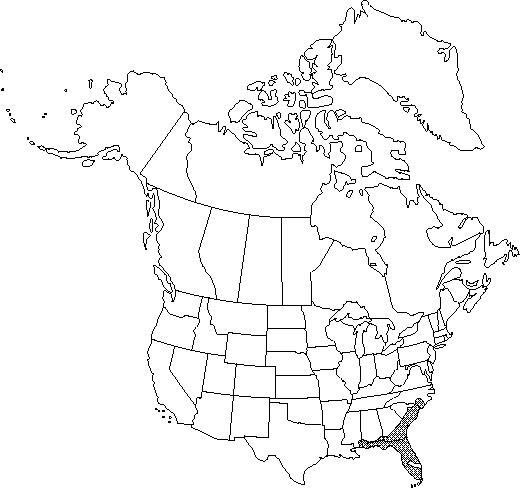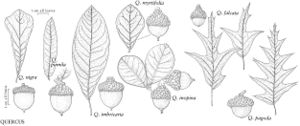Quercus pumila
Fl. Carol., 234. 1788.
Shrubs, deciduous or tardily deciduous, to 1 m. Bark gray to dark brown. Twigs gray-brown to reddish brown, 1-2 mm diam., sparsely to uniformly pubescent. Terminal buds brown to red-brown, ovoid, 2.5-4.5 mm, glabrous or with ciliate scale margins. Leaves: petiole 1.5-4.5 mm, pubescent. Leaf blade oblong to narrowly obovate, 25-100 × 10-33 mm, base acute to rounded, margins entire, revolute, with 1 apical awn, apex acute or obtuse to rounded; surfaces abaxially uniformly gray-brown pubescent, rarely glabrate, adaxially somewhat convex, rugose, glabrous or with scattered hairs along midrib. Acorns annual; cup deeply saucer-shaped to turbinate, 5-12 mm high × 10-15 mm wide, covering 1/3-1/2(-2/3) nut, outer surface pubescent, inner surface densely pubescent, scales rarely involute, often tuberculate, tips tightly appressed, acute; nut globose to ovoid or broadly oblong, 9.5-15 × 9-12 mm, glabrate, scar diam. 5-8 mm.
Phenology: Flowering spring.
Habitat: Dry sandy soils of savannahs, low ridges and oak-pine scrub, occasionally at margins of poorly drained sites
Elevation: 0-100 m
Distribution

Ala., Fla., Ga., Miss., N.C., S.C.
Discussion
Although no hybrid combinations have been formally proposed, D. M. Hunt (1989) has reported evidence of hybridization with Quercus hemisphaerica, Q. incana, Q. myrtifolia, and Q. phellos.
Selected References
None.
